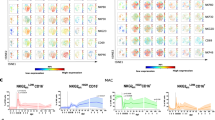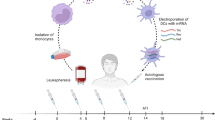Abstract
Natural killer (NK) cells have traditionally been considered nonspecific components of innate immunity, but recent studies have shown features of antigen-specific memory in mouse NK cells. However, it has remained unclear whether this phenomenon also exists in primates. We found that splenic and hepatic NK cells from SHIVSF162P3-infected and SIVmac251-infected macaques specifically lysed Gag- and Env-pulsed dendritic cells in an NKG2-dependent fashion, in contrast to NK cells from uninfected macaques. Moreover, splenic and hepatic NK cells from Ad26-vaccinated macaques efficiently lysed antigen-matched but not antigen-mismatched targets 5 years after vaccination. These data demonstrate that robust, durable, antigen-specific NK cell memory can be induced in primates after both infection and vaccination, and this finding could be important for the development of vaccines against HIV-1 and other pathogens.
This is a preview of subscription content, access via your institution
Access options
Subscribe to this journal
Receive 12 print issues and online access
$209.00 per year
only $17.42 per issue
Buy this article
- Purchase on Springer Link
- Instant access to full article PDF
Prices may be subject to local taxes which are calculated during checkout





Similar content being viewed by others
References
Alpert, M.D. et al. ADCC develops over time during persistent infection with live-attenuated SIV and is associated with complete protection against SIV(mac)251 challenge. PLoS Pathog. 8, e1002890 (2012).
Banks, N.D., Kinsey, N., Clements, J. & Hildreth, J.E. Sustained antibody-dependent cell-mediated cytotoxicity (ADCC) in SIV-infected macaques correlates with delayed progression to AIDS. AIDS Res. Hum. Retroviruses 18, 1197–1205 (2002).
Johansson, S.E. et al. NK cell function and antibodies mediating ADCC in HIV-1-infected viremic and controller patients. Viral Immunol. 24, 359–368 (2011).
Waggoner, S.N., Cornberg, M., Selin, L.K. & Welsh, R.M. Natural killer cells act as rheostats modulating antiviral T cells. Nature 481, 394–398 (2012).
Soderquest, K. et al. Cutting edge: CD8+ T cell priming in the absence of NK cells leads to enhanced memory responses. J. Immunol. 186, 3304–3308 (2011).
Lang, P.A. et al. Natural killer cell activation enhances immune pathology and promotes chronic infection by limiting CD8+ T-cell immunity. Proc. Natl. Acad. Sci. USA 109, 1210–1215 (2012).
Alter, G. et al. Evolution of innate and adaptive effector cell functions during acute HIV-1 infection. J. Infect. Dis. 195, 1452–1460 (2007).
Bandyopadhyay, S. et al. Natural killer cell-mediated lysis of T cell lines chronically infected with HIV-1. Clin. Exp. Immunol. 79, 430–435 (1990).
Bonaparte, M.I. & Barker, E. Killing of human immunodeficiency virus-infected primary T-cell blasts by autologous natural killer cells is dependent on the ability of the virus to alter the expression of major histocompatibility complex class I molecules. Blood 104, 2087–2094 (2004).
Ward, J. et al. HIV modulates the expression of ligands important in triggering natural killer cell cytotoxic responses on infected primary T-cell blasts. Blood 110, 1207–1214 (2007).
Fehniger, T.A. et al. Natural killer cells from HIV-1+ patients produce C–C chemokines and inhibit HIV-1 infection. J. Immunol. 161, 6433–6438 (1998).
Shieh, T.M. et al. Functional analyses of natural killer cells in macaques infected with neurovirulent simian immunodeficiency virus. J. Neurovirol. 7, 11–24 (2001).
Vowels, B.R., Gershwin, M.E., Gardner, M.B. & McGraw, T.P. Natural killer cell activity of rhesus macaques against retrovirus-pulsed CD4+ target cells. AIDS Res. Hum. Retroviruses 6, 905–918 (1990).
Giavedoni, L.D., Velasquillo, M.C., Parodi, L.M., Hubbard, G.B. & Hodara, V.L. Cytokine expression, natural killer cell activation, and phenotypic changes in lymphoid cells from rhesus macaques during acute infection with pathogenic simian immunodeficiency virus. J. Virol. 74, 1648–1657 (2000).
Takahashi, Y. et al. In vivo administration of a JAK3 inhibitor during acute SIV infection leads to significant increases in viral load during chronic infection. PLoS Pathog. 10, e1003929 (2014).
Bostik, P. et al. Decreased NK cell frequency and function is associated with increased risk of KIR3DL allele polymorphism in simian immunodeficiency virus-infected rhesus macaques with high viral loads. J. Immunol. 182, 3638–3649 (2009).
Rouzaire, P. et al. Natural killer cells and T cells induce different types of skin reactions during recall responses to haptens. Eur. J. Immunol. 42, 80–88 (2012).
Majewska-Szczepanik, M., Paust, S., von Andrian, U.H., Askenase, P.W. & Szczepanik, M. Natural killer cell-mediated contact sensitivity develops rapidly and depends on interferon-α, interferon-γ and interleukin-12. Immunology 140, 98–110 (2013).
Paust, S. et al. Critical role for the chemokine receptor CXCR6 in NK cell–mediated antigen-specific memory of haptens and viruses. Nat. Immunol. 11, 1127–1135 (2010).
Paust, S. & von Andrian, U.H. Natural killer cell memory. Nat. Immunol. 12, 500–508 (2011).
O'Leary, J.G., Goodarzi, M., Drayton, D.L. & von Andrian, U.H. T cell– and B cell–independent adaptive immunity mediated by natural killer cells. Nat. Immunol. 7, 507–516 (2006).
Peng, H. et al. Liver-resident NK cells confer adaptive immunity in skin-contact inflammation. J. Clin. Invest. 123, 1444–1456 (2013).
Gillard, G.O. et al. Thy1+ NK [corrected] cells from vaccinia virus-primed mice confer protection against vaccinia virus challenge in the absence of adaptive lymphocytes. PLoS Pathog. 7, e1002141 (2011).
Gazit, R. et al. Lethal influenza infection in the absence of the natural killer cell receptor gene Ncr1. Nat. Immunol. 7, 517–523 (2006).
Mandelboim, O. et al. Recognition of haemagglutinins on virus-infected cells by NKp46 activates lysis by human NK cells. Nature 409, 1055–1060 (2001).
Smith, H.R. et al. Recognition of a virus-encoded ligand by a natural killer cell activation receptor. Proc. Natl. Acad. Sci. USA 99, 8826–8831 (2002).
Fang, M. et al. CD94 is essential for NK cell-mediated resistance to a lethal viral disease. Immunity 34, 579–589 (2011).
Sun, J.C., Beilke, J.N. & Lanier, L.L. Adaptive immune features of natural killer cells. Nature 457, 557–561 (2009).
Ravet, S. et al. Distinctive NK-cell receptor repertoires sustain high-level constitutive NK-cell activation in HIV-exposed uninfected individuals. Blood 109, 4296–4305 (2007).
Scott-Algara, D. et al. Cutting edge: increased NK cell activity in HIV-1-exposed but uninfected Vietnamese intravascular drug users. J. Immunol. 171, 5663–5667 (2003).
Tiemessen, C.T. et al. Cutting edge: unusual NK cell responses to HIV-1 peptides are associated with protection against maternal-infant transmission of HIV-1. J. Immunol. 182, 5914–5918 (2009).
Alter, G. et al. HIV-1 adaptation to NK-cell-mediated immune pressure. Nature 476, 96–100 (2011).
Lopez-Vergès, S. et al. Expansion of a unique CD57+NKG2Chi natural killer cell subset during acute human cytomegalovirus infection. Proc. Natl. Acad. Sci. USA 108, 14725–14732 (2011).
Eisenhardt, M. et al. CD27(+)CD56Bright natural killer cells may be involved in spontaneous clearance of acute hepatitis C in HIV-positive patients. AIDS 28, 1879–1884 (2014).
Reeves, R.K. et al. CD16− natural killer cells: enrichment in mucosal and secondary lymphoid tissues and altered function during chronic SIV infection. Blood 115, 4439–4446 (2010).
Shang, L. et al. NK cell responses to simian immunodeficiency virus vaginal exposure in naive and vaccinated rhesus macaques. J. Immunol. 193, 277–284 (2014).
Robinette, M.L. et al. Transcriptional programs define molecular characteristics of innate lymphoid cell classes and subsets. Nat. Immunol. 16, 306–317 (2015).
Spits, H. et al. Innate lymphoid cells—a proposal for uniform nomenclature. Nat. Rev. Immunol. 13, 145–149 (2013).
Barouch, D.H. et al. Vaccine protection against acquisition of neutralization-resistant SIV challenges in rhesus monkeys. Nature 482, 89–93 (2012).
Flores-Villanueva, P.O. et al. Control of HIV-1 viremia and protection from AIDS are associated with HLA-Bw4 homozygosity. Proc. Natl. Acad. Sci. USA 98, 5140–5145 (2001).
Alter, G. et al. Differential natural killer cell-mediated inhibition of HIV-1 replication based on distinct KIR/HLA subtypes. J. Exp. Med. 204, 3027–3036 (2007).
Zhang, T., Scott, J.M., Hwang, I. & Kim, S. Cutting edge: antibody-dependent memory-like NK cells distinguished by FcRγ deficiency. J. Immunol. 190, 1402–1406 (2013).
Lee, J. et al. Epigenetic modification and antibody-dependent expansion of memory-like NK cells in human cytomegalovirus-infected individuals. Immunity 42, 431–442 (2015).
Schlums, H. et al. Cytomegalovirus infection drives adaptive epigenetic diversification of NK cells with altered signaling and effector function. Immunity 42, 443–456 (2015).
Thomas, R. et al. NKG2C deletion is a risk factor of HIV infection. AIDS Res. Hum. Retroviruses 28, 844–851 (2012).
Marras, F. et al. Natural killer cells in HIV controller patients express an activated effector phenotype and do not up-regulate NKp44 on IL-2 stimulation. Proc. Natl. Acad. Sci. USA 110, 11970–11975 (2013).
O'Connell, K.A., Han, Y., Williams, T.M., Siliciano, R.F. & Blankson, J.N. Role of natural killer cells in a cohort of elite suppressors: low frequency of the protective KIR3DS1 allele and limited inhibition of human immunodeficiency virus type 1 replication in vitro. J. Virol. 83, 5028–5034 (2009).
Choi, E.I., Reimann, K.A. & Letvin, N.L. In vivo natural killer cell depletion during primary simian immunodeficiency virus infection in rhesus monkeys. J. Virol. 82, 6758–6761 (2008).
Moreland, A.J. et al. Characterization of killer immunoglobulin-like receptor genetics and comprehensive genotyping by pyrosequencing in rhesus macaques. BMC Genomics 12, 295 (2011).
Acknowledgements
This work was supported by the National Institutes of Health (grants AI078526, AI096040 and AI095985 to D.H.B.; AI069259, AI111595 and AI112521 to U.H.v.A.; AI067031 to M.A.; and AI118468 to R.K.R.), the American Foundation for AIDS Research (grant 108547-53-RGRL to R.K.R.), the Harvard Center for AIDS Research (grant AI060354 to R.K.R.) and the Ragon Institute of MGH, MIT and Harvard (S.J., M.A., D.H.B. and U.H.v.A.).
Author information
Authors and Affiliations
Contributions
R.K.R., M.A., U.H.v.A. and D.H.B. designed the studies. Haiying Li, S.J., E.B., Hualin Li, J.L.S., V.V., C.M. and L.E. conducted the assays. R.K.R. and D.H.B. wrote the paper with the assistance of all other authors.
Corresponding authors
Ethics declarations
Competing interests
The authors declare no competing financial interests.
Supplementary information
Supplementary Text and Figures
Supplementary Table 1 (PDF 96 kb)
Rights and permissions
About this article
Cite this article
Reeves, R., Li, H., Jost, S. et al. Antigen-specific NK cell memory in rhesus macaques. Nat Immunol 16, 927–932 (2015). https://doi.org/10.1038/ni.3227
Received:
Accepted:
Published:
Issue Date:
DOI: https://doi.org/10.1038/ni.3227
This article is cited by
-
Autologous dendritic cell vaccination against HIV-1 induces changes in natural killer cell phenotype and functionality
npj Vaccines (2023)
-
IL-21 and IFNα therapy rescues terminally differentiated NK cells and limits SIV reservoir in ART-treated macaques
Nature Communications (2021)
-
NK cell memory: discovery of a mystery
Nature Immunology (2021)
-
SIV-induced terminally differentiated adaptive NK cells in lymph nodes associated with enhanced MHC-E restricted activity
Nature Communications (2021)
-
Clonal expansion of innate and adaptive lymphocytes
Nature Reviews Immunology (2020)



